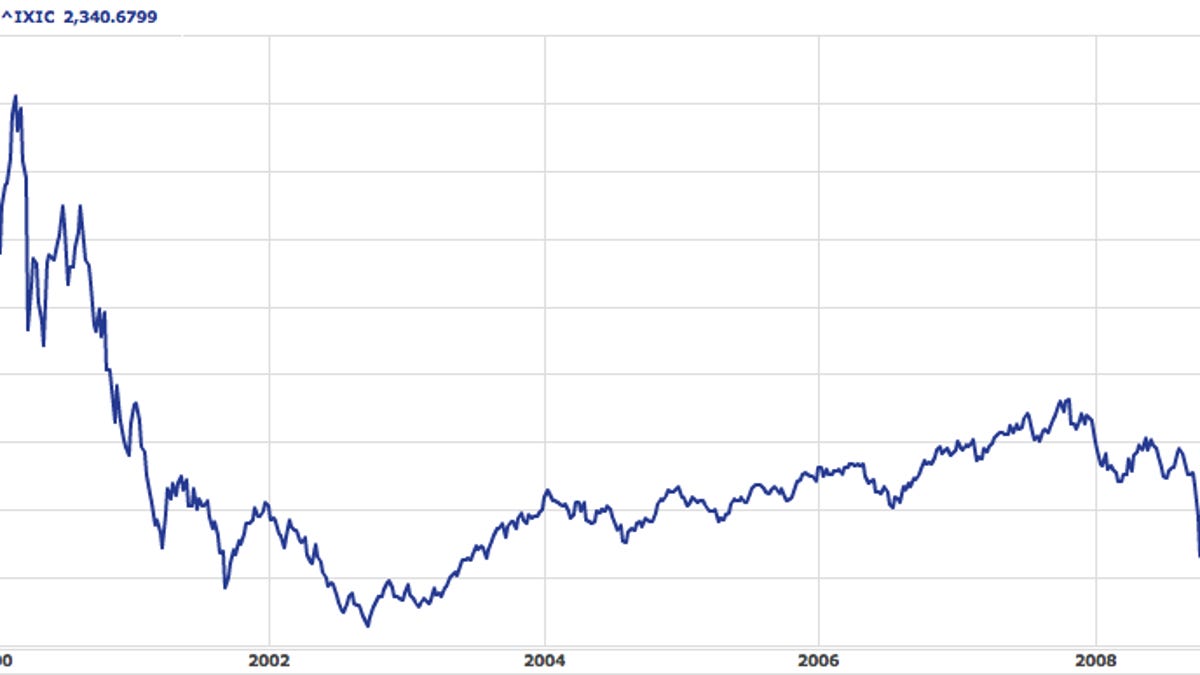 Why You Can Trust CNET
Why You Can Trust CNET Nasdaq 5,000: Ten years after the dot-com peak
Exactly 10 years ago, during the height of the dot-com mania, the Nasdaq reached its all-time high of 5,408.62 on March 10, 2000. It has never recovered.

A decade ago, on March 10, 2000, it seemed almost difficult to find someone skeptical about the dazzling future of dot-com stocks.
An undeniably prescient strategist at Warburg Dillon Read, now part of UBS, told the New York Times that "I don't see the end in sight." The Los Angeles Times quoted a Banc of America Securities analyst as saying that, before "too long," the Nasdaq index would double.
It was exactly 10 years ago that the Nasdaq index reached its all-time peak of 5,048.62, and the tech-heavy index has never come close to recovering. It closed Tuesday at 2,340.68, 54 percent below its dot-com bubble high on March 10, 2000.
If you consider the devaluation of the U.S. dollar during that period caused by the Federal Reserve, the Nasdaq has dropped from an inflation-adjusted high of 6,352--an even more vertiginous plunge of 63.15 percent.
CNET published an article on March 10, 2000, with the headline: "Nasdaq treads above 5,000." Another CNET article published that day quoted a second analyst at Warburg Dillon Read as saying there is a "very powerful momentum pattern that started to form last year" for the Nasdaq that is likely to "remain strong."
That proved to be no more predictive than the BBC's March 10 article noting that the Nasdaq had topped 4,000 only two months earlier, adding that "the insatiable demand for technology shares has made a continued upward surge seem effortless and inevitable." A Prudential Securities analyst was quoted: "If you're an astute observer, your portfolio will reflect what's new and exciting and dynamic."
And who can forget the sequence of books published at the time, each more militantly optimistic than the last, titled, respectively, Dow 36,000, Dow 40,000, and Dow 100,000?
Perhaps the only surprise is that some of those authors remain unapologetic. The co-author of Dow 36,000 was James Glassman, a conservative writer and think tank type later appointed by President Bush as undersecretary of state for public diplomacy. He said last year that the title really was was justified because the Dow eventually will reach that figure--but refused to speculate on whether it might happen before, say, humans colonize the Andromeda galaxy.
This was, of course, an era where it seemed that any day trader could get rich merely by buying shares of a dot-com that may never make a profit. When VA Linux went public in December 1999, in what was arguably the best-performing initial public offering of all time, the stock opened at $30 and closed at $238.25. That was a staggering 698 percent increase and a sign that the dot-com mania was nearing its apex.
The moment trading begin, then-CEO Larry Augustin became a paper billionaire. Today shares of the company--renamed Geeknet--trade at $1.40 with a market capitalization of $86.5 million. (It is, however, profitable.)
Even federal regulators, who ought to know better, took the claims of a new economy seriously. Minutes from the Federal Open Market Committee, released five years later, show that even Fed Chairman Alan Greenspan seemed to believe that the Nasdaq would continue to skyrocket.
"People in the front lines of business operations, such as Jack Welch of GE and Lou Gerstner of IBM, say this is a true revolution" rather than a stock market bubble, Greenspan said at a 1999 meeting. "They have seen nothing like this in their experience."
A few weeks before the Nasdaq peaked, Greenspan said that "we really do not know how this system works. It's clearly new. The old models just are not working."
To be sure, there were some naysayers at the time: David Tice of the Prudent Bear Fund called it, correctly, as "the incredible power of a speculative mania and asset bubble," and so did economist Gary Shilling. But more people were interested in reading about how to get rich quick by investing in the new Nasdaq economy.
Fortunately or unfortunately, the Nasdaq can't claim the worst performance of major stock indexes. During the height of the Japanese asset bubble of the late 1980s, the Nikkei 225 average briefly reached 38,957. It closed Tuesday at 10,559, a drop of 73 percent without adjusting for inflation.

